Introduction
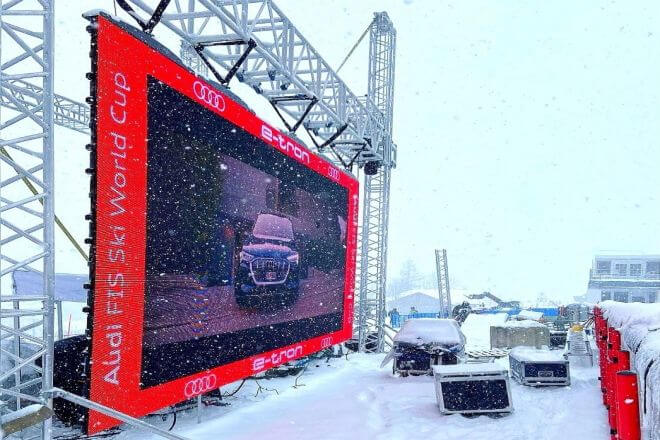
En hiver froid, la température chute fortement et les performances de nombreux appareils seront mises à l’épreuve.
Alors, le Écran d'affichage LED Est-ce que l'appareil continue de démarrer et de fonctionner normalement dans un environnement à température extrêmement basse ? Cela peut être une source d'inquiétude pour de nombreux utilisateurs et commerçants.
Table des matières
1. Une température inférieure à zéro affecte-t-elle vraiment le démarrage de l'écran LED ?
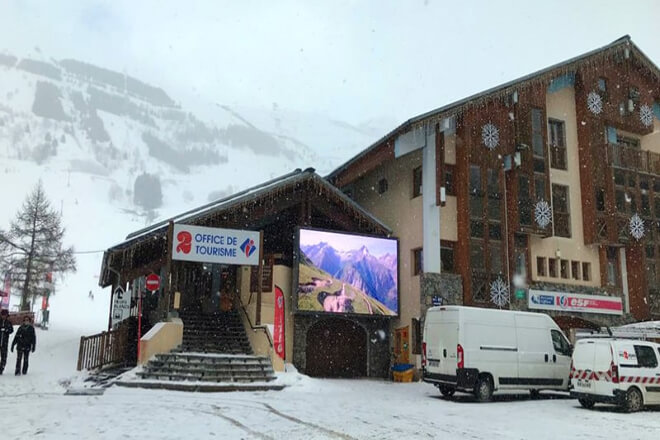
Les températures négatives affectent les performances de démarrage de l'écran LED. Bien que les perles des lampes LED soient relativement résistantes, les composants électroniques qu'elles contiennent ne sont pas aussi résistants au gel.
À mesure que la température baisse, la tension de démarrage de la LED augmente légèrement. En d'autres termes, l'écran doit consommer plus d'électricité pour s'allumer normalement.
Lorsque vous allumez simplement la machine en hiver, vous voyez souvent un écran irrégulier luminosité, et même certains endroits clignotent, ou l'écran réagit plus lentement que d'habitude. Tout cela est dû à une basse température.
En particulier la puce de pilote et le module d'alimentation, leur efficacité diminuera lorsqu'ils fonctionneront dans l'air froid et l'alimentation sera instable, affectant le démarrage global.
De plus, le câblage et l'interface sont également sujets au durcissement en raison du froid, d'un mauvais contact et de problèmes de transmission du signal.
Afin d'éviter ces problèmes, les fabricants utilisent généralement des puces et des alimentations adaptées aux basses températures, et ajoutent un petit « poêle chauffant » dans l'écran pour aider à réchauffer l'écran et assurer un démarrage en douceur en hiver.
De cette façon, l'écran LED peut fonctionner de manière stable et normale dans un environnement froid, et sa durée de vie est plus longue.
2. Quel type d'écran LED peut résister au « froid extrême » ?
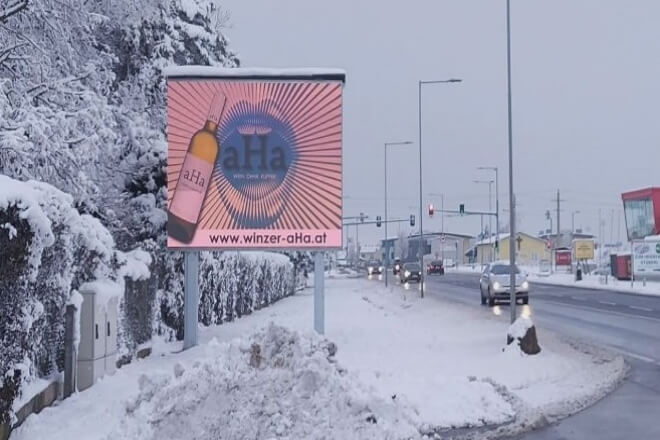
Si vous souhaitez que l’écran LED « résiste » à des températures extrêmement froides, l’écran lui-même doit être spécialement préparé pour cet environnement.
Les écrans LED ordinaires de qualité commerciale, bien qu'ils soient adaptés à une utilisation quotidienne, sont sujets à des problèmes lorsqu'ils sont confrontés à des vents froids de plusieurs dizaines de degrés en dessous de zéro.
Les écrans LED de qualité industrielle sont spécialement conçus pour résister au gel. Leurs alimentations et leurs puces de commande sont conçues pour une utilisation basse température, garantissant ainsi une utilisation optimale de l'écran par temps froid.
Une bonne alimentation électrique peut non seulement fournir une alimentation électrique stable, mais également résister au gel.
Les puces de pilote à basse température peuvent faire fonctionner les perles de lampe LED de manière sensible, sans scintillement, et l'effet d'affichage est plus stable.
De plus, ce type d'écran LED résistant au froid extrême peut s'adapter à une plage de température plus large, de moins 30 degrés à 60 degrés, et peut fonctionner normalement indépendamment des hivers rigoureux ou des étés chauds.
La coque extérieure et les fils de connexion de l'écran LED utiliseront également des matériaux antigel et anti-fissures pour éviter de devenir cassants lorsqu'ils sont froids, ce qui entraînerait l'interruption de la transmission du signal.
En général, l'écran LED extrêmement résistant au froid a ajouté une « protection épaisse » de la puce et de l'alimentation à la coque extérieure afin qu'il puisse fonctionner en continu et de manière stable dans un environnement extrêmement froid sans craindre de geler à mi-chemin.
3. Quelle peut être la raison pour laquelle l'écran LED ne démarre pas par temps extrêmement froid ?
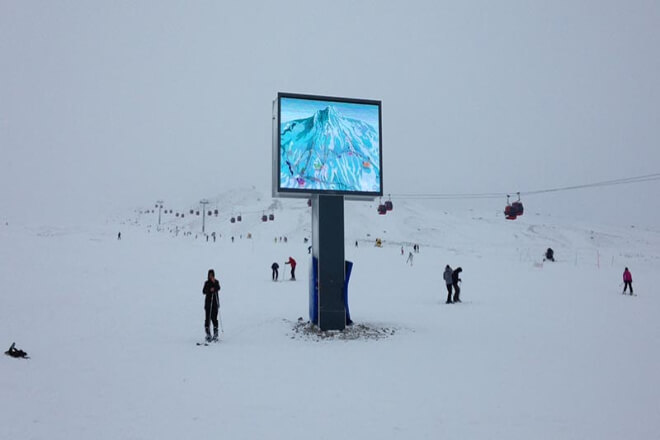
Par temps extrêmement froid, l'affichage LED ne s'allume pas souvent. Les principales raisons sont les suivantes :
En hiver, le temps est froid et « l’action » des composants électroniques de l’alimentation électrique ralentit, ce qui entraîne un courant insuffisant nécessaire au démarrage.
En particulier, certaines alimentations électriques ordinaires peuvent démarrer automatiquement la fonction de protection en raison d'un courant instable et couper directement l'alimentation électrique, ce qui fait que l'écran ne s'allume pas du tout.
Même s'il peut être allumé, les fluctuations de tension et de courant sont importantes, ce qui entraînera un scintillement ou un affichage anormal de l'écran.
Par conséquent, dans les zones froides, il est très important de choisir une alimentation de haute qualité qui a été testée à basse température.
Lorsque l'air froid rencontre la surface de l'écran ou la zone à haute température à l'intérieur, la vapeur d'eau se condense en gouttelettes d'eau ou même gèle.
Si de l'eau pénètre dans le circuit imprimé, le connecteur ou la puce de commande, un court-circuit risque de se produire. Un court-circuit peut non seulement empêcher l'écran de démarrer, mais aussi provoquer un court-circuit.
Mais dans les cas les plus graves, des composants peuvent également être brûlés, ce qui rend les réparations très difficiles.
Afin d’éviter ces problèmes, les écrans LED doivent généralement être conçus pour être étanches et résistants à l’humidité.
Et certains installeront également des équipements de chauffage pour éviter la condensation et l’accumulation de glace.
Le système de contrôle de l'écran LED comprend des puces et des cartes mères. Les basses températures ralentissent les composants électroniques internes et ralentissent la vitesse de réponse.
Lors du démarrage, le système de contrôle peut ne pas être en mesure de terminer la détection et le traitement du signal à temps, ce qui entraîne des blocages ou des blocages directs, ce qui peut entraîner un échec de démarrage de l'écran.
Afin de faire face à cette situation, les écrans LED résistants au froid utiliseront des puces de contrôle spécifiquement adaptées aux basses températures et optimiseront également le logiciel pour assurer un fonctionnement fluide même par temps froid.
En général, l'échec du démarrage des écrans LED dans des environnements extrêmement froids est généralement le résultat de l'influence combinée de l'alimentation électrique, du circuit et des facteurs environnementaux.
Pour que l'écran LED fonctionne normalement par temps froid, il faut en plus choisir un équipement de qualité industrielle adapté aux basses températures.
Il est également nécessaire d'éviter la condensation et d'effectuer un entretien quotidien. Si nécessaire, un dispositif de chauffage peut être installé.
C'est seulement de cette manière que l'écran LED peut démarrer de manière stable et s'afficher normalement pendant l'hiver froid.
4. Comment faire pour que l'écran LED « démarre en quelques secondes » même à basse température ?
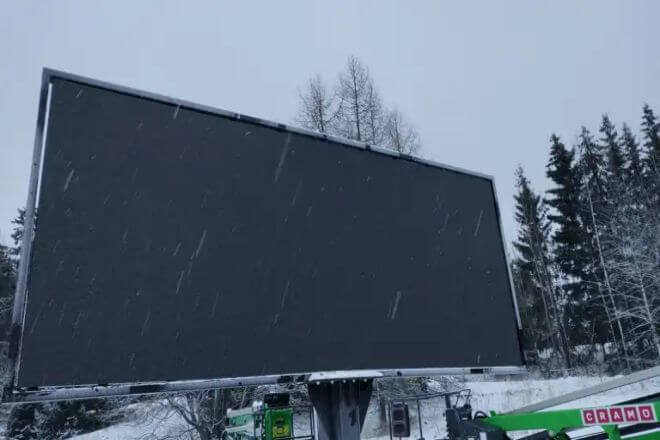
1). Préchauffer avant d'allumer
En hiver, si l'écran LED est alimenté directement, l'écran ne s'allumera pas ou ne scintillera pas car la température est trop basse, le courant n'est pas fort ou la puce réagit lentement.
Le préchauffage consiste à démarrer le dispositif de chauffage interne avant de démarrer officiellement la machine.
Pour que l'écran et les composants électroniques à l'intérieur puissent d'abord se réchauffer, puis que la température soit en place avant la mise sous tension officielle de la machine, afin que le démarrage soit plus rapide et plus stable.
2). « Isolation » avec un boîtier à température constante ou un module de chauffage
Certains écrans LED sont équipés d'un boîtier à température constante. En termes simples, il s'agit de construire une petite pièce chauffée pour l'écran afin d'éviter que la température interne ne baisse trop.
Certains installent des plaques ou des modules chauffants à des endroits stratégiques. Une fois le courant rétabli, ces « bébés chauds » aident à dissiper le givre et la vapeur d'eau.
Empêchez l'écran de geler ou le circuit de devenir humide et assurez-vous que le circuit et la puce peuvent fonctionner normalement.
3). Un système de contrôle intelligent pour régler la température
Aujourd’hui, de nombreux écrans LED sont très intelligents, dotés de capteurs de température capables de détecter la température de l’écran à tout moment.
Lorsque la température est basse, le système de contrôle allume automatiquement l'appareil de chauffage.
Lorsque la température atteint la plage appropriée, il s'éteint automatiquement.
Cela permet non seulement d'économiser de l'électricité, mais garantit également que l'écran peut démarrer rapidement par temps froid, évitant ainsi divers problèmes causés par des températures élevées et basses.
En termes simples, si vous souhaitez que l'écran LED démarre en quelques secondes, même à des températures inférieures à zéro, vous ne devez pas seulement disposer d'un matériel de chauffage performant.
Il dispose également d'un contrôle intelligent qui « comprend la température ». La combinaison des deux permet à votre écran LED de résister au froid, d'être connecté à tout moment et d'être stable.
5. Précautions d'installation et de mise au point des écrans LED extérieurs en hiver
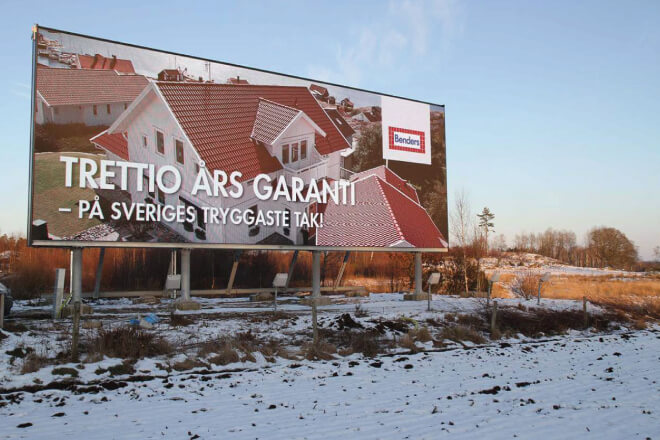
L’installation et le débogage des écrans LED extérieurs en hiver ne peuvent pas être pris à la légère.
Les basses températures engendreront de nombreux défis. Voici les principaux points à prendre en compte :
1). Impact des travaux hivernaux sur les modules et les câbles
Le temps froid rend les modules LED et les câbles durs et cassants, et ils sont facilement endommagés si vous ne faites pas attention pendant le fonctionnement.
Les circuits imprimés et les composants des modules sont sensibles aux basses températures et un refroidissement excessif peut provoquer des fissures dans les joints de soudure ou endommager les composants.
L'élasticité des matériaux des câbles diminue à basse température et ils sont faciles à casser ou ont un mauvais contact.
Par conséquent, lors de la construction, essayez d'éviter les flexions et les tractions brusques, travaillez avec précaution et utilisez des modules et des câbles fabriqués à partir de matériaux résistants au froid.
2). Mesures d'étanchéité et de dégivrage
La pluie, la neige et les basses températures en hiver peuvent facilement provoquer de la condensation ou même de la glace sur l’écran.
Une fois que la vapeur d’eau pénètre dans le circuit interne, le risque de court-circuit et de corrosion augmente considérablement.
Pour la protection, il est nécessaire de se concentrer sur l'étanchéité lors de l'installation, par exemple en utilisant des produits d'étanchéité de haute qualité pour garantir que les interfaces et les espaces de l'écran sont complètement fermés.
Dans le même temps, le matériau de la coque doit également avoir de bonnes propriétés d’imperméabilité et de résistance au froid.
Des coques en alliage d'aluminium ou en plastique spécial sont couramment utilisées, qui sont à la fois antirouille et ne craignent pas le gel et les fissures, garantissant la sécurité de l'écran.
3). Comment tester la fiabilité à des températures extrêmes
Après l’installation et le débogage, assurez-vous d’effectuer un « test de température extrême » pour simuler le fonctionnement dans un environnement à basse température en hiver.
Habituellement, l'écran LED est placé dans une boîte à température constante, ou la température est rapidement ajustée avec un équipement de chauffage/refroidissement.
Pour observer si l'écran démarre en douceur et s'il y a des anomalies luminosité, écart de couleur ou points morts.
Le test doit également détecter la stabilité de l'alimentation électrique et du système de contrôle à basse température pour garantir qu'il peut réellement résister à l'épreuve de l'hiver.
6. Guide d'entretien de l'utilisateur : Comment entretenir l'écran LED en hiver ?
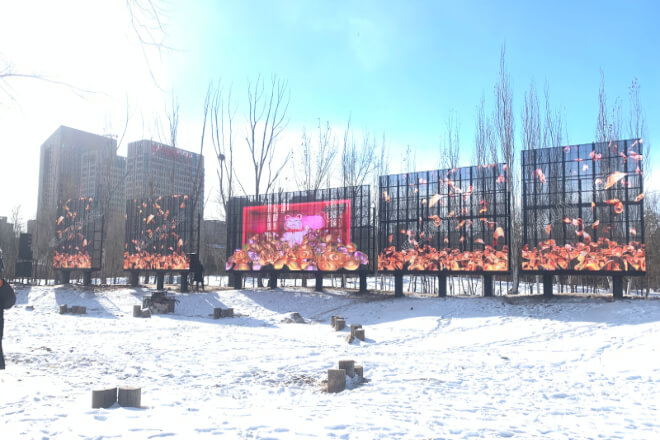
La basse température et l’humidité élevée en hiver posent de nombreux défis à l’utilisation et à la maintenance des écrans d’affichage LED.
Afin d'assurer le fonctionnement stable de l'écran et de prolonger sa durée de vie, les utilisateurs doivent prêter attention aux points suivants en hiver :
1). Vérifiez régulièrement le câblage, le drainage et le dégivrage.
Par temps froid, les systèmes de câblage et de drainage sont sujets au gel ou à l’accumulation d’eau.
Les utilisateurs doivent vérifier régulièrement tous les câbles et interfaces pour s’assurer qu’il n’y a pas de desserrage, de rupture ou de corrosion.
Dans le même temps, veillez à ce que les trous de drainage de l'écran ne soient pas obstrués pour éviter la rétention de l'eau de pluie et de fonte des neiges et provoquer un blocage de la glace.
Si du givre ou de la glace est détecté sur la surface et les parties clés de l'écran, des mesures de dégivrage doivent être prises à temps pour éviter d'endommager l'écran ou d'affecter l'affichage.
2). Séquence de mise sous et hors tension : éviter les chocs électriques
Lors du démarrage de l'écran LED en hiver, il est recommandé de suivre strictement la séquence de mise sous tension et hors tension recommandée par le fabricant pour éviter d'endommager les composants électroniques causés par le choc de tension instantané de l'alimentation.
En règle générale, allumez d'abord l'appareil de chauffage ou le système de préchauffage, puis allumez le système d'affichage une fois que la température de l'écran augmente.
Lors de l'arrêt, le système d'affichage doit également être éteint en premier et le dispositif de chauffage doit être déconnecté en dernier pour garantir que l'ensemble du processus se déroule sans problème et réduire les pertes matérielles.
3). Avez-vous besoin de modes de fonctionnement différents en hiver et en été ?
De nombreux écrans LED avancés prennent en charge le réglage automatique des modes de fonctionnement en fonction de la saison.
En hiver, vous pouvez activer la protection basse température et le mode chauffage pour augmenter le temps de chauffage et éviter que l'écran ne gèle et ne démarre.
En été, privilégiez la dissipation thermique et réduisez votre consommation d'énergie. Les utilisateurs doivent adapter leurs modes de fonctionnement en fonction des conditions climatiques et des recommandations du fabricant afin de garantir un écran en parfait état tout au long de l'année.
7. Conclusion
Grâce à l’introduction de cet article, nous comprenons que les températures inférieures à zéro ont un certain impact sur le démarrage et le fonctionnement des écrans d’affichage LED.
Cependant, en choisissant le bon équipement, en prenant des mesures de protection efficaces et en l'entretenant raisonnablement, il est tout à fait possible de garantir que l'écran LED fonctionne de manière stable par temps froid.
Enfin, si vous souhaitez en savoir plus sur les écrans d'affichage LED, veuillez nous contacter.
